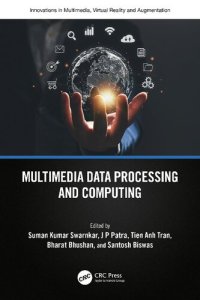
Ebook: Multimedia Data Processing and Computing
- Genre: Computers // Organization and Data Processing
- Year: 2023
- Publisher: CRC Press
- Language: English
- pdf
This book focuses on different applications of multimedia with supervised and unsupervised data engineering in the modern world. It includes AI-based soft computing and machine techniques in the field of medical diagnosis, biometrics, networking, manufacturing, Data Science, automation in electronics industries, and many more relevant fields. Multimedia Data Processing and Computing provides a complete introduction to Machine Learning (ML) concepts, as well as practical guidance on how to use Machine Learning tools and techniques in real-world data engineering situations.
It is divided into three sections. In this book on multimedia data engineering and Machine Learning, the reader will learn how to prepare inputs, interpret outputs, appraise discoveries, and employ algorithmic strategies that are at the heart of successful data mining. The chapters focus on the use of various Machine Learning algorithms, neural net- work algorithms, evolutionary techniques, fuzzy logic techniques, and Deep Learning techniques through projects, so that the reader can easily understand not only the concept of different algorithms but also the real-world implementation of the algorithms using IoT devices. The authors bring together concepts, ideas, paradigms, tools, methodologies, and strategies that span both supervised and unsupervised engineering, with a particular emphasis on multimedia data engineering. The authors also emphasize the need for developing a foundation of Machine Learning expertise in order to deal with a variety of real-world case studies in a variety of sectors such as biological communication systems, healthcare, security, finance, and economics, among others. Finally, the book also presents real-world case studies from Machine Learning ecosystems to demonstrate the necessary Machine Learning skills to become a successful practitioner.
Using advanced techniques of Machine Learning such as deep neural networks, ChatGPT is able to comprehend natural language questions and generate responses that are human-like in nature. Deep neural networks are a specific type of Machine Learning algorithm that are designed to simulate the functioning of the human brain. This is accomplished by creating multiple connected levels of artificial neurons that are able to process data in a hierarchical fashion. The use of deep neural networks has enabled ChatGPT to learn from a large corpus of text data and generate responses that are contextually appropriate and linguistically sophisticated. Therefore, ChatGPT represents an impressive application of AI technology. By using Machine Learning algorithms to process natural language inputs, ChatGPT is capable of mimicking human-like conversations and generating responses that are relevant and coherent.
The primary users for the book include undergraduate and postgraduate students, researchers, academicians, specialists, and practitioners in Computer Science and engineering.
It is divided into three sections. In this book on multimedia data engineering and Machine Learning, the reader will learn how to prepare inputs, interpret outputs, appraise discoveries, and employ algorithmic strategies that are at the heart of successful data mining. The chapters focus on the use of various Machine Learning algorithms, neural net- work algorithms, evolutionary techniques, fuzzy logic techniques, and Deep Learning techniques through projects, so that the reader can easily understand not only the concept of different algorithms but also the real-world implementation of the algorithms using IoT devices. The authors bring together concepts, ideas, paradigms, tools, methodologies, and strategies that span both supervised and unsupervised engineering, with a particular emphasis on multimedia data engineering. The authors also emphasize the need for developing a foundation of Machine Learning expertise in order to deal with a variety of real-world case studies in a variety of sectors such as biological communication systems, healthcare, security, finance, and economics, among others. Finally, the book also presents real-world case studies from Machine Learning ecosystems to demonstrate the necessary Machine Learning skills to become a successful practitioner.
Using advanced techniques of Machine Learning such as deep neural networks, ChatGPT is able to comprehend natural language questions and generate responses that are human-like in nature. Deep neural networks are a specific type of Machine Learning algorithm that are designed to simulate the functioning of the human brain. This is accomplished by creating multiple connected levels of artificial neurons that are able to process data in a hierarchical fashion. The use of deep neural networks has enabled ChatGPT to learn from a large corpus of text data and generate responses that are contextually appropriate and linguistically sophisticated. Therefore, ChatGPT represents an impressive application of AI technology. By using Machine Learning algorithms to process natural language inputs, ChatGPT is capable of mimicking human-like conversations and generating responses that are relevant and coherent.
The primary users for the book include undergraduate and postgraduate students, researchers, academicians, specialists, and practitioners in Computer Science and engineering.
Download the book Multimedia Data Processing and Computing for free or read online
Continue reading on any device:

Last viewed books
Related books
{related-news}
Comments (0)